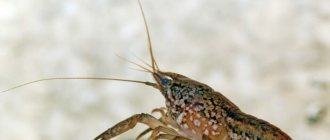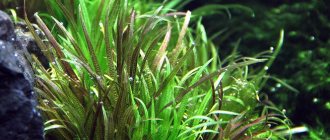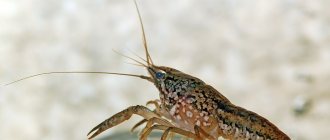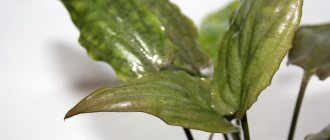What you need to know about the content
In nature, the dwarf shark lives in the fresh waters of rivers. It is found in fresh water rivers and can be found in the rivers of Thailand and Laos. Fish swim not in the open sea, but in the thickets of lakes. The demand for this type of fish is explained by the fact that fillets are valued, which is why fish are reared in captivity.
In aquariums, conditions similar to natural ones are created so that the fish reaches its maximum size. And in nature it grows up to one meter, sometimes more. In captivity it reaches a maximum of 70 cm, or even less.
Reproduction
Shark barbs rarely breed in an aquarium. Spawning is stimulated by hormonal injections and is possible in a 1500-liter aquarium. Puberty occurs at 4 years of age.
Sex differences
You can determine the sex by examining the barb in detail. Sexual differences appear upon reaching 14 cm in length. Females have a rounded abdomen, while males have a cocky character.
Spawning
- Prepare a spawning tank with good filtration. Raise the temperature a few degrees and soften the water. Cover the bottom with moss and plant a couple of large bushes of plants in the corners.
- Place two males and a female in the spawning tank. A few days before spawning, feed the female with plant foods and the males with protein.
- After the eggs are laid and fertilized, remove the parents. The female lays up to 10 thousand eggs.
- Add methylene blue to the water to prevent fungal growth. After two days, filter the water with charcoal.
- Perform daily water changes of 50%. Maintain stable hardness and temperature.
- After two days, the eggs hatch into fry, which grow quickly if kept correctly.
- Feed the fry live dust. Make sure everyone is well fed. Young animals are sensitive to the quality and stability of water parameters.
Conditions of detention
A mini predator cannot be kept in a small aquarium, like an ornamental fish. For a suitable pet, you should purchase an aquarium of 50 liters or more. Since the fish is shy, you need to add several grottoes or caves made of pebbles to the interior of the aquarium.
The fish is active, so it needs a place to swim and hide. Attention should be paid to keeping the pet; pangasius is kept in the aquarium taking into account the following conditions:
- The volume of the aquarium is at least 50 liters. water;
- Change 30% of water daily;
- Same water temperature, which varies from 24 to 290C;
- The volume of water is calculated - 30-40 liters of water per individual, and if the fish begins to grow, therefore the volume of water increases;
- Availability of water filtration and water aeration;
- Several species of predators should not be bred in one aquarium, since each species has different conditions of detention and character.
Be sure to pay attention to the arrangement of the bottom of the aquarium. Due to the fact that domestic sharks are quite active plants, they must either be planted deep in the ground or planted in a separate pot.
The bottom can be covered with sand, small pebbles or even large stones. You can also alternate everything together.
In captivity, the predator feeds on granulated food; shrimp, squid or frozen fish can also be used as animal products.
When feeding, you should adhere to the following recommendations:
- You can do fasting days for fish once a month;
- Food should be varied;
- When feeding, it is best to have a schedule - feeding in the morning and evening, or only in the evening or only in the morning.
The main rule is that fish should not be overfed!
You should be careful when choosing neighbors who will live with the fish. Because a dwarf predator can easily eat a prey that differs in size by a third. The best option is either the predators live on their own or swim with fairly large species of other fish.
It should be remembered that the aquarium predator inherited the character of its relatives, so it is rare that a shark will share both food and a home with one of the fish. The fish is on the move - in search of food. But, she has not only weak eyesight, but also a weak nervous system. This is the reason why fish rush so often at the slightest noise. You need to be careful when caring for it; during stress, it can be injured by decorations or on the walls of the aquarium.
And pangasian catfish can pretend to be dead in a critical situation. And not only lie motionless, but also change its characteristic dark color into light colors.
Compatibility
Shark balus get along with active and non-conflicting aquarium fish, but neighbors that are too small (2–3 cm in length) will be eaten. Slow catfish that are awake at night and live on the bottom are also suitable. Full compatibility of the Baloo with others is ensured not only by similarities in temperament and size, but also in the required conditions.
Successful examples of fish living with Balu:
- swordtails;
- platies;
- thorns;
- barbs;
- iris;
- mollies;
- plectostomus;
- corridors;
- cardinals;
- gourami;
- loaches;
- large rasboras.
Species of dwarf shark
Since different types of dwarf sharks can be found in nature, they can also be found at home.
Shark catfish is a species of predator that is most similar to its marine relative. Grows up to 70 cm in captivity, but this depends on the size of the aquarium and conditions.
In order for a dwarf shark to grow in captivity, it is necessary to take into account its timid nature and ability to jump out of the aquarium, so the aquarium must be high enough.
When keeping pangasius in an aquarium, it should be taken into account that catfish and small fish cannot be kept in the same aquarium at the same time, since they will serve as food for the shark.
Blackfin shark is an aquarium fish similar to sharks. A distinctive feature is the black ends of the fins. The fish has a shy character, but it is quite voracious. The main thing in feeding is to know when to stop.
The black shark is a pangasius aquarium fish, only it is an unusual gray color, but is black. Grows up to 50 cm, with proper care. It is the color of the fish that acts as a signal, that is, if it is poorly cared for, the shark loses its black color and becomes gray. This type of decorative shark has a rather insidious character, so you should be careful when choosing neighbors.
The black bicolor shark is the most beautiful member of the family. The black body abruptly turns into a white belly. This species is the most popular species of ornamental aquarium sharks. It is not demanding in terms of nutrition, but has an aggressive character. But due to its beauty, lovers of exotic fish forgive it everything.
The dwarf shark is a Pangasius aquarium fish, the smallest shark from the family Pangasius hypophthalmus. This mini copy fits in the palm of your hand and also glows. The glow effect is obtained due to photophore plaques that are located on the fins and abdomen. It is not recommended to feed the dwarf shark by hand, as it has an aggressive nature.
And those who still want to acquire a small predator should pay attention to the aquarium fish shark catfish. If you compare it with a shark, then the Pangasius aquarium catfish is a miniature copy of the sea robber. There are only two subspecies of shark catfish - the high-finned Pangasius and the low-finned Suchi.
The Siamese pangasius or pangasius hypophthalmus has a dense, elongated body, with a triangular head and a large mouth. And the large dorsal triangular fins make the catfish look similar to a shark. Juveniles are gray in color, gradually becoming lighter towards the abdominal cavity of the fish. When young, individuals have two horizontal stripes from the gills to the tail. When the pangasius shark catfish matures, the stripes disappear and the color becomes uniform.
A rainbow catfish will look spectacular in the same aquarium with a black two-color predator.
Area
The Siamese pangasius is an inhabitant of freshwater bodies of Laos and Thailand. In appearance, this catfish is very similar to a shark, which is why it is often bred by aquarists all over the world. In countries located in southeast Asia, shark catfish is considered a commercial fish; its meat is used by sushi bar chefs to prepare a variety of exotic dishes. In addition to Pangasius sutchi, there is also a predatory subspecies Pangasius hypophthalmus, characterized by its larger size and aggressive nature.
Shark Ball
Author: Egor · Published 10/10/2016 · Updated 05/30/2017
Freshwater fish of the carp family. Popular tropical fish. Another name is silver shark. The shark baloo is similar in appearance to the roach: a thin, long body, laterally compressed; big eyes. Large scales resemble many small silver-steel mirrors. The fins can be transparent, yellow or with a yellowish tint, the dorsal is sickle-shaped, the edging is black, wide. The back is slightly darker than the sides and belly. The dorsal fin resembles that of a shark. In the photo in front of us is a real giant shark. The mouth is located below, there is no mustache. A nimble, jumping, timid fish; loves to live in a flock of more than five individuals. Native to Thailand, Southeast Asia. Loves ponds with running water. The movements of the fish are graceful and smooth. Susceptible to stress (panics in case of sudden movements during water purification). It takes a month to get used to new conditions. Life expectancy is about 10 years. Hypersensitive to water pollution. Listed in the Red Book.
Diseases
Domestic sharks have strong immunity. With improper care and non-compliance with flocking, the following are susceptible to the ball:
- Obesity. Shark barbs are voracious; they are ready to eat all the food poured into them, even if there is too much of it.
- Ichthyophthyriasis. A disease known as "semolina". Appears as white dots on the body. Introduced with live food or plants. Treated with medications from a pet store.
- Aeromonosis. A disease to which cyprinids are predisposed. In a sick shark fish, the skin becomes inflamed, hemorrhages appear, and the scales become brittle. Methylene blue and salt baths are used against aeromonosis.
- Poisoning. High levels of ammonia provoke poisoning in carp sharks. Protruding eyes appear, the population of the aquarium prefers the upper water level and greedily swallows air. Smoothly improve the quality of water to normalize the well-being of your pets.
- Hypoxia. The disease is caused by a lack of oxygen. Improving aeration solves the problem.
Diseases
If you follow all the rules for care and maintenance, the fish will not have any health problems. But in some cases:
- ulcerative formations have appeared on the surface (need to be treated with a solution of potassium permanganate or placed in a saline solution for a week);
- redness may be observed near the gill fins (presence of nitrates in the water, urgently eliminate the cause);
- destruction of antennae or fins (bad water);
- the fish loses activity, settles to the bottom, stops eating (water temperature is not warm enough);
- semolina (ichthyophthyriasis) rashes form on the surface of the fish, similar to semolina, these are fungal formations. The sick individual must be removed and treated with a solution of green malachite.
Although there are unpleasant moments in keeping any species, but looking at a small shark swimming serenely in a home aquarium, you understand that nothing can destroy the majestic charm it has created.
It is quite difficult to breed this species at home, in an aquarium. Therefore, it is customary to buy shark catfish fry brought from the countries of their historical homeland. They adapt well to new conditions and grow quickly.
Reviews
The experience of aquarists confirms the need to keep sharks in a spacious container. Many people find shark pets interesting and fascinating, as numerous reviews indicate. Some aquarists report keeping balus with goldfish and African cichlids. This experience is rather an exception, because these fish are incompatible.
Feeding Siamese catfish
Freshwater sharks are predators, and therefore they have no problems with appetite. Food is taken both in the upper and middle layers of the reservoir.
Attention! Food must contain a sufficient amount of minerals and substances useful for pangasius; their lack will affect the growth and appearance of your pet.
Correct diet:
- feeding three times a day, in portions appropriate to the age of the fish;
- protein, an essential component of each serving;
- Beef meat minced through a meat grinder will be useful in the diet of shark catfish;
- low-fat fish varieties for catfish are good suppliers of phosphorus;
- Shrimp and squid should be included in the diet;
- we must not forget about the benefits of microelements from plant foods for the normal growth of Siamese catfish (cucumbers, cabbage, potatoes);
- boiled buckwheat or rice porridge can also be given to fish.
Considering that shark catfish is a fairly voracious fish, you should not overfeed it. Obesity comes on quickly, and getting rid of it is problematic. For prevention, “fasting” days are arranged twice a week, when shark catfish do not receive any food.











